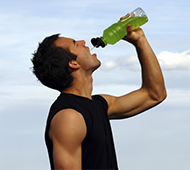Signs and symptoms of imminent dehydration
Professor Ryszard Gellert, Professor of Medicine, Department of Nephrology at the Medical Centre for Postgraduate Medicine and the IV Clinical Ward of Internal Medicine at the Bielański Hospital in Warsaw, Poland.
Dehydration refers to a deficit of total body water volume, best represented by hypovolaemia (diminished blood volume) and a reduction of body weight (BW). The day-to-day variation in water content in healthy active individuals outbalances changes in solute content, is asymptomatic, and does not exceed 1% of body weight (BW)1. Dehydration may be mild (1-3% BW in adults and children >10kg, and 5% BW in children<10kg), moderate (3-10% BW), or severe (>10% BW). Each stage is represented by a set of clinical symptoms and signs, and by the extent of laboratory abnormalities.
Thirst is undoubtedly the most recognised symptom of dehydration. It appears after dehydration of 1% BW and hypovolaemia have developed, but does not increase significantly with progressing dehydration, so is a poor qualitative indicator of dehydration.
 Thirst from progressive dehydration is preceded by a decreased output of dark-yellow urine, which goes initially unnoticed. Reduction in urinary and salivary flow can be noticed at dehydration <0.5% BW. The urine flow rate (30-100 ml/hour), colour, specific gravity (1.01-1.03g/l), osmolality, and conductivity, are all useful indicators of the extent of physiological dehydration2,3. However, the maximum urine concentration is reached at dehydration of about 1.0% BW, so urine characteristics cannot quantify dehydration.
Thirst from progressive dehydration is preceded by a decreased output of dark-yellow urine, which goes initially unnoticed. Reduction in urinary and salivary flow can be noticed at dehydration <0.5% BW. The urine flow rate (30-100 ml/hour), colour, specific gravity (1.01-1.03g/l), osmolality, and conductivity, are all useful indicators of the extent of physiological dehydration2,3. However, the maximum urine concentration is reached at dehydration of about 1.0% BW, so urine characteristics cannot quantify dehydration.
Mild dehydration is felt as unpleasant condition and negatively affects mood, and cognitive and motor control functions. Unexplained tiredness, headaches and sore throat, decreased attention and reduced short-term memory, have been reported with only 1-3% body weight reduction4. Physical signs indicative of mild dehydration are slight dryness of mouth mucosa and tongue, dry skin of normal turgor (skinfold), increased pulse rate while standing as compared to supine position (increase by ≥15 bpm). No changes in blood pressure or heart rate can be noticed in supine position until dehydration reaches 4% BW5. The arteriolar refill time can be also slightly extended, but does not exceed 2s.
Increased haematocrit, and plasma albumin and blood haemoglobin concentrations are suggestive of mild dehydration. However, only the plasma osmolality (Posm) of 301 +/- 5 mmol/kg is a good static indicator of dehydration. For dynamic assessment of developing dehydration, changes of 9 mmol/kg H2O (plasma osmolality), 0.010 (urine specific gravity), and 2.5% decrease in body mass are statistically valid at the 95% probability level6.
In summary, the best indicators of normal hydration are body weight net changes <0.5%, light-yellow urine, and lack of thirst.
LITERATURE:
(1) Cheuvront SN et al. Int. J. Sport Nutr. Exerc. Metab. 2004, 14: 532-40.
(2) Shirreffs SM et al. Med. Sci. Sports Exerc. 1998, 30: 1598–1602.
(3) Casa DJ et al. J Athl Train. 2000. 35: 212–224.
(4) Panel on Dietary Reference Intakes for Electrolytes and Water. Standing Committee on the Scientific Evaluation of Dietary Reference Intakes.Food and Nutrition Board. Dietary Reference Intakes for Water, Potassium, Sodium, Chloride, and Sulfate. The National Academies Press
Washington, D.C., 2005, p. 73-185.
(5) E. F. Adolph , Physiology Of Man In The Desert., Interscience Publishers, Inc., New York, London., 1947.
(6) Cheuvront SN at al. Am J Clin Nutr. 2010, 92: 565-73.